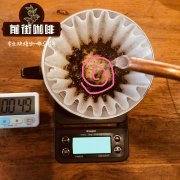Introduction to batch S2020 of Kenya Kandigii Kandigo processing Station _ brief introduction to the characteristics of Kenyan coffee beans

Professional coffee knowledge exchange more coffee bean information please follow the coffee workshop (Wechat official account cafe_style)
This is the coffee we personally went to Kenya for auction in the new season. It came from the Kandigi processing station. The treatment station was set up in the 1970s to handle fresh coffee fruits from five village areas of Kioru, Taai, Mitarune, Rugomo and Kithiro and Kiamiriru. The coffee planting in the area where the treatment station is located is mainly divided into two production seasons, the preterm season is from May to June, and the main production season lasts from November to December, mainly SL28 and Ruiru 11 varieties, of which SL28 accounts for more than 98%.
The coffee in the area where the Kandigi treatment station is located is picked manually, and only the coffee cherries with all red fruits are selected for further processing. Coffee cherries enter the fermentation tank after the first step of peeling by the peeler. Coffee cherries are usually coated with a layer of pectin, which is the main source of coffee's natural sugar and contributes most of the acidity and flavor of coffee.
In the following fermentation stage, depending on the temperature, the coffee will be left in the fermentation tank for 12-24 hours, which is the critical time to experiment with different coffee flavors. With the progress of fermentation, the pectin will crack and split from the endocarp of the coffee, and the coffee beans will be washed with water, the attached pectin will be cleaned, and then it can be dried off the ground, which is commonly known as the African bed for 7-15 days.
The Kenyan coffee processing station marks the batch number of coffee with each batch, and their work is admirable in the coffee traceability system I have seen. When we were in Kenya, we needed to test hundreds of different batches of Kenyan coffee every day, and we got Kandigi S2020 batches through medium tea and Dormans.
It has the typical black plum and tomato flavor of Kenyan coffee and the sweet and sour taste of berry juice.
END
Important Notice :
前街咖啡 FrontStreet Coffee has moved to new addredd:
FrontStreet Coffee Address: 315,Donghua East Road,GuangZhou
Tel:020 38364473
- Prev

Kenya Kana Yi treatment station washed coffee beans story _ Kenya Kana Yi coffee is good?
Professional coffee knowledge exchange more coffee bean information please follow the coffee workshop (Wechat official account cafe_style) this is our new production season to Kenya to choose the coffee for auction, it comes from the Kainamui processing station. The treatment station, established in 1963, is located on the upwind slope of Mount Kenya, with a total of 2000 members, mainly male (1200 male members), as a whole.
- Next

Kenyan fat boy Kititu PB how to rush _ EAFCA auction third place-Gititu cooperative
Professional coffee knowledge exchange more coffee bean information please follow the coffee workshop (Wechat official account cafe_style) East Africa quality coffee auction third Kenya AA TOP-Gititu cooperative EAFCA, East Africa quality Coffee Association, established in July 2000, is composed of ten coffee-producing countries, including Pulong, Ethiopia, Kenya, Malawi and Luwang
Related
- Detailed explanation of Jadeite planting Land in Panamanian Jadeite Manor introduction to the grading system of Jadeite competitive bidding, Red bid, Green bid and Rose Summer
- Story of Coffee planting in Brenka region of Costa Rica Stonehenge Manor anaerobic heavy honey treatment of flavor mouth
- What's on the barrel of Blue Mountain Coffee beans?
- Can American coffee also pull flowers? How to use hot American style to pull out a good-looking pattern?
- Can you make a cold extract with coffee beans? What is the right proportion for cold-extracted coffee formula?
- Indonesian PWN Gold Mandrine Coffee Origin Features Flavor How to Chong? Mandolin coffee is American.
- A brief introduction to the flavor characteristics of Brazilian yellow bourbon coffee beans
- What is the effect of different water quality on the flavor of cold-extracted coffee? What kind of water is best for brewing coffee?
- Why do you think of Rose Summer whenever you mention Panamanian coffee?
- Introduction to the characteristics of authentic blue mountain coffee bean producing areas? What is the CIB Coffee Authority in Jamaica?

